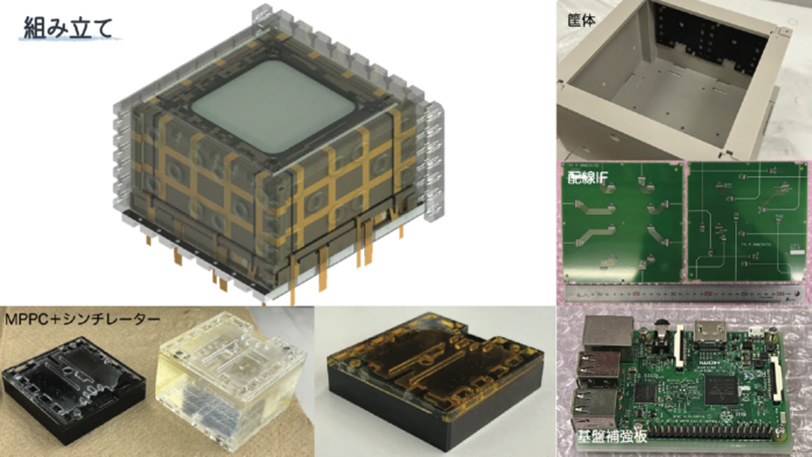



X線やガンマ線など、高エネルギーの電磁波は地球の大気を透過することができず、長時間にわたる天体観測には人工衛星が不可欠です。そのため、X線ガンマ線天文学は衛星技術が発達する1970年代から急速に発展し、いまだ50年程度の歴史が浅い分野と言えます。一方で、X線・ガンマ線では爆発現象やブラックホール、超高温プラズマなど躍動する宇宙の姿を垣間見る重要なエネルギー帯で、とくにMeVガンマ線は主要な原子核反応、つまり元素合成の鍵となる波長です。これまで、MeV領域の観測はNASA(米国宇宙局)やESA(欧州宇宙機関)による10トンクラスの大型衛星による先行例がわずか数例あるのみで、とくに2000年以降は観測が行われていません。とくにガンマ線はレンズや反射鏡で集光できず、可視化することが難しいことに加え、衛星開発にかかる膨大な費用・マンパワーが大きな障壁となっています。
そこで、本研究プロジェクトでは数十キログラムの小型衛星に搭載可能な小型かつ高感度のX線ガンマ線撮像カメラを開発し、実際に衛星として打ち上げることで、「小回りの良い」宇宙科学の新たな方向性を提案します。ここで開発するカメラは、「核医学・粒子線治療」グループで開発したハイブリッド・コンプトンカメラ(Hybrid-CC)を宇宙用に最適化し、とくにキロノバなど未知の突発天体の観測に挑みます。他にも、宇宙空間では太陽フレアやガンマ線バーストなど様々な突発天体が知られており、また我々の銀河中心からは 511keV の強いガンマ線ライン放射が知られています。これらの精密測定を通じ、新しいMeVガンマ線天文学の確立を目指します。
さらに、地球上の大気現象、とくに雷からも強いガンマ線が放射されることが知られています。雷雲では強い電場により電子が加速され、制動放射によりガンマ線が生ずると考えられ、その放射機構は宇宙における放射機構と極めて良い類似を示します。つまり、雷ガンマ線の観測は衛星観測の前哨戦であり、科学的にも多く成果をもたらすことが実証されてきました。本研究では、宇宙観測班、大気観測班が互いの知見を共有しつつ、高エネルギー現象の解明を目指します。

現在、世界中では年間300基以上の小型衛星が打ち上げられ、先端宇宙工学の検証や産業・通信目的で利用されています。一方で、10kg以上の衛星には、可視光・X線観測をはじめとする科学ミッションに果敢に利用されているものもあります。東京工業大大学では、2021年に50kgの「ひばり」衛星を打ち上げ、可変形状制御による姿勢制御実験に成功しました。続く「うみつばめ」衛星は2025年ごろの打ち上げを目指し、紫外線望遠鏡を搭載することで「キロノバ」など重力波天体の観測に挑みます。本プロジェクトは、この3号機として(仮)INSPIRE衛星を検討し、主ミッションはHybrid-CC によるMeVガンマ線帯での突発天体や銀河面観測、また、サブミッションとして工学系フォーメーションフライトなどを実施する予定で、鋭意開発を進めています。

宇宙用観測装置として、Box タイプのHybrid-CC の開発を進めています。センサーのサイズは 10x10cm, 重量は 約10kgと小型ですが、側面にも吸収体を設置することで感度を高め、1MeV 以下では 過去のCOMPTEL検出器を凌駕する性能(感度、解像度とも)が期待できます。視野は ピンホールモードで±30°、コンプトンモードで±60°を実現することが可能です。また、観測方向や姿勢を工夫することで、銀河面だけでなく太陽を直接観測することができるよう、ミッションの最適化を行っています。太陽から高エネルギー・ガンマ線が放射されていることは知られていますが、核ガンマ線の精密測定やフレア・静穏時のスペクトル測定の比較など、系統的な調査は非常に乏しい状況です。INSPIREの打ち上げは2027年前後であり、とくに太陽活動が激しい「極大期」 に相当します。極大期では中規模クラス以上のフレアが一日数回は期待され、我々のガンマ線カメラであれば数分観測すれば十分なデータが得られることが予想されます。

MeVガンマ線観測の成立性については、銀河面を視野とした場合に現実的に達成できる観測時間(~106 秒/視野)を見積もり、ここで達成される感度の計算、さらには優先的に観測すべき天体やサイエンスについても検討を進めています。また、太陽同期軌道 (LST 10-12時)を想定し、軌道上で卓越する大気バックグラウンドや宇宙X線背景放射を考慮した詳細シミュレーションを行っています。さらに、天体のスペクトルなども加味して、様々な天体を観測下場合の検出有意度などを求め、最終的な観測計画へと反映します。これら理学ミッションが概ね達成されたのち、サブミッションとなる工学の軌道制御実験(FF関連)を開始する予定です。単純化のため、LVLH姿勢を想定し、衛星本体の形状変化による空力と小型スラスタのみで、分離したTM との相対位置と距離を高精度に制御する予定です。

雷観測に関しては、新潟県十日町市の観測サイトにコンプトンカメラを3台設置し、またエネルギー分解能に優れるHPGe 半導体検出器を設置して観測を継続しています。2022年度には「世界初」となる雷雲のガンマ線イメージングに成功し、地球物理分野のトップジャーナルである Geophysical Research Letter (GRL誌)に論文が掲載されました。金沢市内では、京都大学が進める「雷雲プロジェクト」と連携し、小型の放射線モニターである「コガモ」の設置個所を70 箇所まで拡大しました。また、コンプトンカメラを金沢大学にも設置して、観測を継続しています。2023年にはシチズンサイエンスの最初の大きな成果として、多拠点観測の「コガモ」データを連携し、雷ガンマ線と一致する領域から可視の雷がはじまる現象を発見しました。これらの成果も、GRL誌に掲載されました。

High-energy electromagnetic waves such as X-rays and gamma rays cannot penetrate the Earth's atmosphere, making satellites indispensable for long-term astronomical observations. Consequently, X-ray and gamma-ray astronomy have rapidly developed since the 1970s with the advancement of satellite technology, making it a relatively young field with only about 50 years of history. On the other hand, X-rays and gamma rays are important energy bands for observing dynamic cosmic phenomena such as explosions, black holes, and extremely hot plasmas. Particularly, MeV gamma rays are key wavelengths for major nuclear reactions, such as element synthesis. To date, only a few large-scale satellite observations in the MeV region have been conducted by NASA and ESA, and no observations have been made since 2000. Gamma rays are especially challenging to visualize as they cannot be focused with lenses or mirrors, and the enormous cost and manpower required for satellite development are significant barriers.
Therefore, this research project aims to develop a compact and highly sensitive X-ray and gamma-ray imaging camera that can be mounted on small satellites weighing tens of kilograms and launch it as a satellite, proposing a new direction for "nimble" space science. The camera developed here will optimize the hybrid Compton camera (Hybrid-CC) developed by the "Nuclear Medicine and Particle Beam Therapy" group for space use, particularly challenging the observation of unknown transient celestial events such as kilonovae. Other known transient celestial events in space include solar flares and gamma-ray bursts, and strong 511 keV gamma-ray line emissions from the center of our galaxy. Through precise measurements of these phenomena, we aim to establish a new MeV gamma-ray astronomy.
Furthermore, it is known that strong gamma rays are emitted from atmospheric phenomena on Earth, particularly lightning. In thunderclouds, electrons are accelerated by strong electric fields, producing gamma rays through bremsstrahlung, showing a very good analogy to radiation mechanisms in space. In other words, observing lightning gamma rays is a prelude to satellite observations and has been proven to yield significant scientific results. In this study, the space observation team and the atmospheric observation team will share their knowledge to elucidate high-energy phenomena.

Currently, over 300 small satellites are launched annually worldwide, used for verifying advanced space engineering and industrial and communication purposes. On the other hand, satellites weighing over 10 kg are also boldly used for scientific missions, including visible light and X-ray observations. In 2021, Tokyo Institute of Technology launched the 50 kg "Hibari" satellite, successfully conducting attitude control experiments through variable shape control. The subsequent "Umitsubame" satellite is aiming for a launch around 2025, equipped with an ultraviolet telescope to observe gravitational wave sources such as kilonovae. This project is considering the (tentatively named) INSPIRE satellite as its third unit, with its main mission being the observation of transient celestial events and the galactic plane in the MeV gamma-ray band using the Hybrid-CC. The sub-mission includes engineering formation flight experiments, with development underway.

We are developing a box-type Hybrid-CC as a space observation instrument. The sensor is compact, with a size of 10x10 cm and a weight of about 10 kg, but the sensitivity is enhanced by installing absorbers on the sides. It is expected to outperform past COMPTEL detectors in both sensitivity and resolution below 1 MeV. The field of view can be realized at ±30° in pinhole mode and ±60° in Compton mode. Additionally, by optimizing the observation direction and attitude, we aim to observe not only the galactic plane but also the Sun directly. It is known that high-energy gamma rays are emitted from the Sun, but systematic studies such as precise measurements of nuclear gamma rays and comparisons of spectra during flares and quiescent periods are extremely scarce. The INSPIRE launch is scheduled around 2027, coinciding with the "solar maximum" period of intense solar activity. During the solar maximum, several moderate-class flares are expected daily, and it is anticipated that sufficient data can be obtained with our gamma-ray camera within a few minutes of observation.

Regarding the feasibility of MeV gamma-ray observations, we estimate achievable observation times (~10^6 seconds/field of view) for observations with the galactic plane in view, calculate the sensitivity achieved here, and consider priority celestial objects and science for observation. We also conduct detailed simulations considering the prevailing atmospheric background and cosmic X-ray background radiation in orbit, assuming a sun-synchronous orbit (LST 10-12). Additionally, taking into account the spectra of celestial objects, we calculate the detection significance of various celestial objects under observation, and reflect these findings in the final observation plan. Once these scientific missions are generally achieved, we plan to start engineering orbital control experiments (related to FF) as a sub-mission. To simplify, we assume an LVLH attitude, aiming to control the relative position and distance with a separated TM using only the aerodynamics and small thrusters from shape changes of the satellite body.

For lightning observations, we have installed three Compton cameras and HPGe semiconductor detectors with excellent energy resolution at the observation site in Tokamachi City, Niigata Prefecture, and continue to observe. In 2022, we achieved the "world's first" gamma-ray imaging of thunderclouds, and the results were published in the top geophysics journal, Geophysical Research Letters (GRL). In Kanazawa City, in collaboration with Kyoto University's "Thundercloud Project," we have expanded the installation locations of small radiation monitors called "Kogamo" to 70 sites. Additionally, we have installed a Compton camera at Kanazawa University and continue to observe. In 2023, as the first major achievement of citizen science, we discovered the phenomenon where visible lightning begins from regions coinciding with gamma rays observed in multiple locations using "Kogamo" data. These results were also published in GRL.

最終更新日:2024年7月1日
Last Update: 1 July 2024